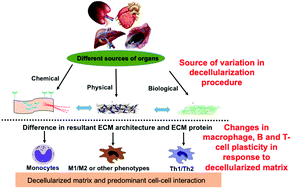Regulation of decellularized matrix mediated immune response
Abstract
The substantially growing gap between suitable donors and patients waiting for new organ transplantation has compelled tissue engineers to look for suitable patient-specific alternatives. Lately, a decellularized extracellular matrix (dECM), obtained primarily from either discarded human tissues/organs or other species, has shown great promise in the constrained availability of high-quality donor tissues. In this review, we have addressed critical gaps and often-ignored aspects of understanding the innate and adaptive immune response to the dECM. Firstly, although most of the studies claim preservation of the ECM ultrastructure, almost all methods employed for decellularization would inevitably cause a certain degree of disruption to the ECM ultrastructure and modulation in secondary conformations, which may elicit a distinct immunogenic response. Secondly, it is still a major challenge to find ways to conserve the native biochemical, structural and biomechanical cues by making a judicious decision regarding the choice of decellularization agents/techniques. We have critically analyzed various decellularization protocols and tried to find answers on various aspects such as whether the secondary structural conformation of dECM proteins would be preserved after decellularization. Thirdly, to keep the dECM ultrastructure as close to the native ECM we have raised the question “How good is good enough?” Even residual cellular antigens or nucleic acid fragments may elicit antigenicity leading to a low-grade immune response. A combinative knowledge of macrophage plasticity in the decellularized tissue and limits of decellularization will help achieve the native ultrastructure. Lastly, we have shifted our focus on the scientific basis of the presently accepted criteria for decellularization, and the effect on immune response concerning the interaction between the decellularized extracellular matrix and macrophages with the subsequent influence of T-cell activation. Amalgamating suitable decellularization approaches, sufficient knowledge of macrophage plasticity and elucidation of molecular pathways together will help fabricate functional immune informed decellularized tissues in vitro that will have substantial implications for efficient clinical translation and prediction for in vivo reprogramming and tissue regeneration.



 Please wait while we load your content...
Please wait while we load your content...